|
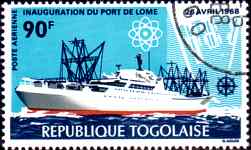
|
Maritime Topics On Stamps :
The Three Nuclear-Powered Freighters!
|
With nuclear propelled ships, a chain reaction of nuclear fusion generates
heat which is used to create steam which in turn is driving the steam
turbines.
Major advantages of this propulsion are the small amount of fuel required,
and the nearly unlimited operating range. Disadvantages are the high costs
for building, maintenance and waste disposal. Then there is the fear and
perceived risk in the minds of people living in the ports-of-call.
The first nuclear powered ship in the world was the U.S. submarine
'Nautilus', commissioned in 1955. Next came the Russian icebreaker 'Lenin',
built in 1959.
This page reports on the three merchant vessels which were built thereafter:
the American 'Savannah', the German 'Otto Hahn', and the Japanese 'Mutsu'.
All three were experimental and served to research the economic feasibility
of nuclear propulsion for merchant ships.
|
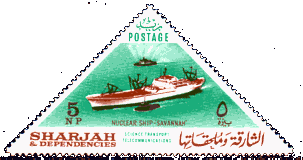
|
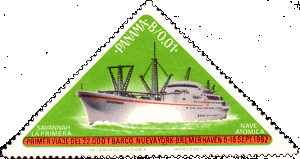
| |
The NS 'Savannah' was the world’s first nuclear powered merchant vessel.
Here some specifications: start of design and construction in 1956, launched
in 1959, and commissioned in 1962. Length 545 ft, beam 81 ft, draft 29.5 ft,
21,840 gross tons, speed 21 knots, turbine power 22,000 propeller HP.
She was built at the yard of New York Shipbuilding Corp., Camden, as a
freighter with cabins for 60 passengers, swimming pool included. She was to
be a pure research vessel, yet served more as a public relations vehicle
campaigning for ‘Atoms for Peace’.
American news media referred to her as a 'show boat' with a cargo capacity of
only 9,000 tons.
|
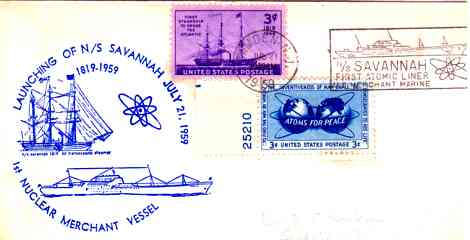
|
|
As told on this cover, the 'Savannah' was named after the first ship to
cross the Atlantic Ocean --partially-- under steam (with detachable paddle
wheels), in 1819.
After commissioning, lengthy disputes between owners and maritime unions
delayed the maiden voyage. Finally, in June 1964 she sailed from New York to
Bremerhaven in ten days, with commercial cargo in her holds. Her sailing
career came to an end in 1971 and the ship was laid up. The support was just
too expensive. Average operating costs per year were said to amount to $2.9
million. Other sources reported a need for annual subsidies of 4 million
dollars per year.
|
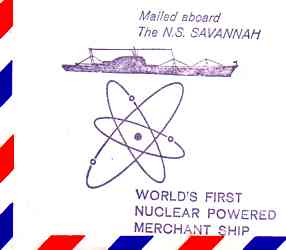
|
During her eight years of service, 'Savannah' steamed more than 480,000
nautical miles.
Praised as a technical success, she was an economical failure. Today she is
berthed at the Maritime Museum, Mt. Pleasant, South Carolina.
|
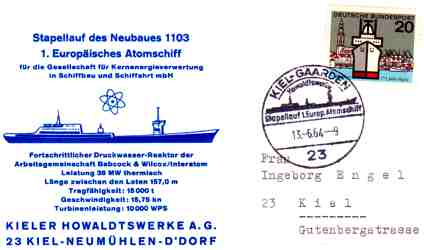
|
|
The German 'Otto Hahn' was the world’s second nuclear powered merchant vessel.
Here are some specifications: 1963 start of building, 1964 launching, 1968
commissioning. Length 564 ft, beam 76 ft, draft 30 ft, 16,870 gross tons,
15,000 tdw, speed 15.75 knots, turbine power 11,000 propulsion HP, with a
crew of 73 men and 36 researchers and scientists.
She was built as an ore carrier at Howaldtswerke, Kiel.
|
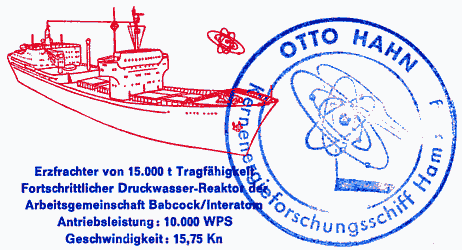
|
|
For ten years, 'Otto Hahn' operated without encountering any problems
economic realities excepted. On 126 voyages the ship steamed 642,000 nautical
miles and transported 776,000 tons cargo.
All this time she used just 80 kilograms uranium fuel.
Again, a technical success and an economic failure.
Decommissioning was decided on in 1978.
Three years the ship was nuclear decontaminated at the expense of 11
million dollars.
|
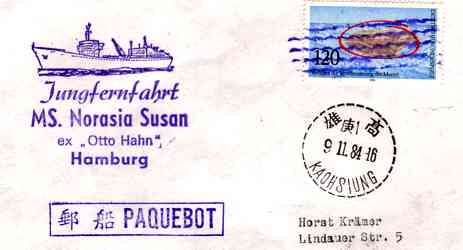 |
The 'Otto Hahn' was sold to the Rickmers shipping company of Germany. During
1982-83 she was rebuilt as a container ship with diesel engine propulsion.
Her new name became 'Trophy', later on she was renamed 'Norasia Susan' (1983)
and 'Norasia Helga' (1985).
|
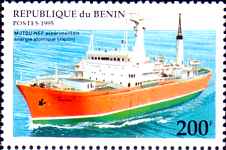
|
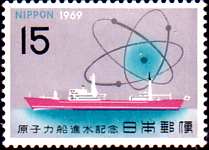
| |
Japan’s 'Mutsu' was the third nuclear powered merchant vessel.
Here some specifications:
1964 launching, 1970 delivery from the yard -- and officially commissioned
only twenty years later (see below).
Length 426.5 ft, beam 62 ft, draft 23 ft, 8,242 gross tons, speed 16.5
knots, turbine power 10,000 propulsion HP.
Commissioning had been planned for 1972, but serious safety problems
developed with the reactor’s radiation shield. After lengthy repairs and a
few short voyages, technical problems arose again. In addition, there were
massive protests and demonstrations by Japanese fishermen against the ship.
Finally, she was decommissioned never having carried any commercial cargo.
|
1990 it was announced that 'Mutsu's engine tests - with nuclear power - had
been a success.
From 1990 to 92 she undertook four research voyages with positive results.
Afterwards, in 1995, the
reactor was removed and nuclear decontamination commenced.
The stamp shows the Japanese launching date of the 12th June, 1964.
|
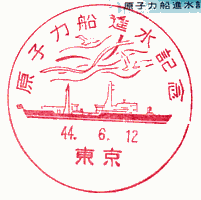
|
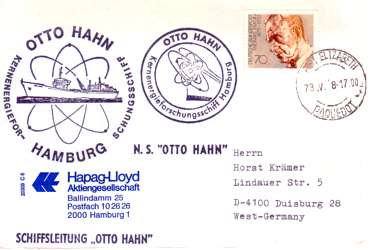
|
Lessons learned with these three research vessels led to the unequivocal
conclusion that for merchant shipping nuclear propulsion is just too
expensive. The reactors are very heavy, require double hull construction,
extra-strengthened hull ribs, and sophisticated radiation shields.
In addition, many ports prohibit entry to nuclear powered vessels fearing the
dangers of radiation.
Yet, we find many nuclear reactors in the world’s major navies, especially in
submarines and aircraft carriers.
For these ships unlimited seagoing time, speed and powerful engines are of
utmost importance.
For the same reason, many Russian icebreakers haves nuclear propulsion.
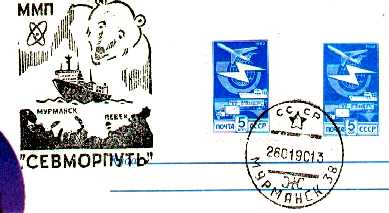
| |
From 1983 to 1988 the Russians built the fourth nuclear powered merchant
vessel, a Lash-Carrier named 'Sevmorput'.
Some specs: Length 853 ft, beam 105 ft, draft 39 ft, 33,980 tdw, speed 20
knots, 40,000 propulsion HP. She has an icebreaking bow, belongs to the
Murmansk Shipping Company and serves along the 'northern Seaway'.
We see the 'Sevmorput' on the above letter.
| |
|